Grow Your Own: Top Container Garden Ideas for Vegetables & Herbs
Affiliate Disclosure: This post contains affiliate links. If you make a purchase through these links, I may earn a small commission at no extra cost to you. I only recommend products I believe will add value to your gardening journey. Thank you for your support!
Unlock the potential of your patio, balcony, or windowsill and enjoy the freshest produce right at your fingertips. This guide provides an inspiring collection of top container gardening ideas, empowering you to cultivate a thriving edible garden of vegetables and herbs, regardless of how much space you have.
Why Go Container? Unlocking Your Urban Garden Potential
Ever stared longingly at those idyllic garden photos, then glanced around your urban abode, sighing at the sheer lack of, well, DIRT? Perhaps your ‘backyard’ is a concrete slab, your ‘front yard’ is a sidewalk, and your idea of ‘compost’ is last night’s takeout container. Fear not, aspiring green-thumbed city dweller! You don’t need a sprawling estate (or even a modest patch of lawn) to cultivate your very own edible paradise. Enter the humble, yet mighty, container garden.
Think of it as gardening on your terms, without the commitment issues of a full-blown farm. No more wrestling with stubborn, rock-hard soil that’s probably seen more car exhaust than earthworms. With containers, you are the master of your soil destiny – choosing the perfect fluffy, nutrient-rich blend that your veggies will adore (and thank you for, probably with extra yields).
But wait, there’s more! (Queue infomercial music). Do you have a balcony that gets blasted by sun in the morning, then sulks in shade by afternoon? Or perhaps a window sill that’s only truly glorious for a few hours? No problem! Container plants are the ultimate nomads. Just pick ’em up and move ’em! Chasing the sun becomes a fun daily ritual, not a desperate plea to the sky gods. And speaking of moving, if a rogue pigeon decides your lettuce patch is the perfect landing strip, simply relocate your leafy greens. Try doing THAT with an in-ground garden!
This portability also makes pest control less of a ‘battle royale’ and more of a ‘polite suggestion to leave.’ Is a certain creepy crawly taking a liking to your basil? Isolate and treat, rather than declaring war on your entire property. Plus, for those of us whose gardening experience extends to keeping a succulent alive for more than a week (a win!), containers offer a manageable, less intimidating entry point. You control the water, the nutrients, and the general vibe. It’s gardening with training wheels, but the kind that still lets you grow impressive tomatoes.
So, ditch the dream of owning acres you’ll never use, and embrace the reality of transforming your tiny urban footprint into a vibrant, edible oasis. Your future self (the one munching on homegrown herbs) will thank you. And your neighbors? They’ll just be plain jealous.
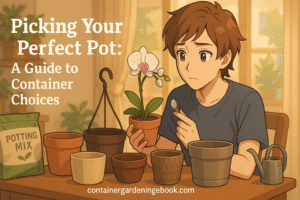
Picking Your Perfect Pot: A Guide to Container Choices
Alright, you’ve picked your plant’s swanky new pad – whether it’s a chic terracotta, a portable plastic, or a surprisingly stylish grow bag. But a beautiful house is nothing without a solid foundation, right? You wouldn’t build a mansion on quicksand, and your plants definitely won’t thrive in the wrong kind of dirt. Forget the notion that “dirt is dirt.” In the world of container gardening, your soil isn’t just a place for roots to hang out; it’s their entire universe, their dining room, and their oxygen supply.
Remember how we said you’re the master of your soil destiny? This is where you truly shine! No more battling compacted clay or nutrient-depleted sand that’s probably seen more car tires than earthworms. You get to play God (in a good, plant-nurturing way) and craft the perfect environment.
The Great Soil Debate: Why Not Just Dig Up Your Backyard?
Hold your shovels, urban pioneers! While that patch of earth outside might look perfectly innocent, it’s actually a supervillain in disguise when confined to a pot. Garden soil (the stuff in your yard) is designed for, well, GARDENS. It’s heavy, it compacts easily, and it’s full of all sorts of delightful things like weed seeds, diseases, and microscopic critters that are perfectly happy in the vast expanse of the ground but become suffocating, root-rotting monsters in a tiny container.
Enter the superhero of container gardening: potting mix (often called potting soil, but it’s technically “mix” because it rarely contains actual soil). This isn’t just dirt; it’s a carefully engineered, fluffy, nutrient-delivery system designed for the unique challenges of pot life. Think of it as gourmet, aerated, spa-like living conditions for your plant’s roots.
Let’s settle this once and for all:
So, please, for the love of all that is green, invest in good quality potting mix. Your plants will thank you by not staging a dramatic wilting protest.
Drainage: The Unsung Hero (and Root Rot’s Worst Enemy)
You’ve heard it before, and you’ll hear it again: drainage is non-negotiable. Imagine trying to breathe underwater. That’s what your plant’s roots feel like when they’re sitting in soggy, waterlogged soil. Without proper drainage, your beautiful container garden will quickly become a sad, slimy, root-rotting mess. It’s like a bad roommate situation where the water just won’t leave.
This is why those drainage holes in your chosen pot are absolutely vital. If your pot doesn’t have them, grab a drill and make some! (Carefully, of course. We don’t want any emergency room visits before your first harvest).
Now, here’s where a common myth needs to be busted like a stubborn weed: DO NOT put a layer of gravel, broken pottery shards, or packing peanuts at the bottom of your pot. Yes, your grandma might have done it. Yes, it seems logical. But scientifically, it’s about as useful as a screen door on a submarine.
This seemingly helpful layer actually creates something called a “perched water table.” Instead of draining freely, water collects ABOVE the gravel layer, right where your plant’s roots are. It’s like putting a sponge on top of a pile of rocks – the water still sits in the sponge until it’s completely saturated. This means your plant’s roots are sitting in a perpetually wet zone, leading directly to the dreaded root rot. Just good potting mix and drainage holes are all you need. Simpler, right? And your plants will be much happier for it.
So, choose wisely, water thoughtfully, and give your plants the foundation they deserve. They’ll pay you back in delicious, homegrown goodness.
Your pot isn’t just a pretty face; it’s your plant’s entire world. Choosing the right one is crucial for its health and happiness, impacting everything from soil moisture to root temperature. Think of it as finding the perfect pair of shoes – comfort, fit, and material all matter!
Here’s a breakdown of common container materials and what they bring to the table:
Choosing the Perfect Pot
A container gardener’s guide to the pros and cons of different pot materials.
Size Matters (A Lot!): Don’t try to cram a full-sized tomato plant into a tiny herb pot. Plants need adequate space for their roots to grow, access nutrients, and remain stable. A general rule of thumb:
- Herbs & Leafy Greens (Lettuce, Spinach, Basil): 6-8 inch diameter pots.
- Bush Beans, Carrots, Radishes: 8-12 inch diameter pots.
- Peppers, Eggplant, Bush Cucumbers: 12-16 inch diameter pots.
- Tomatoes, Zucchini, Pole Beans: 18-24 inch diameter pots (or larger!).
Remember, a larger pot holds more soil, which means more nutrients and moisture, reducing how often you need to water and feed.
Don’t Forget Drainage! No matter how beautiful your pot, if it doesn’t have drainage holes, your plants are doomed to root rot. If your chosen container lacks them, grab a drill and make some!
Ultimately, the best pot is one that meets your plant’s needs, fits your space, and appeals to your aesthetic. Once you’ve chosen your plant’s perfect home and ensured proper drainage, the final piece of the puzzle is filling it with the ideal growing medium. While we’ve championed general potting mix, did you know you can tailor it even further for specific plants? For a truly customized foundation, check out this handy [Custom Potting Mix Recipe Designer] to create the perfect blend for any veggie, herb, or even a fussy cactus!
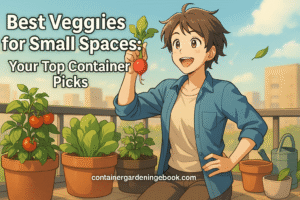
Best Veggies for Small Spaces: Your Top Container Picks
Now that your containers are primed and your potting mix is perfectly fluffed, it’s time for the exciting part: picking your plant partners! While the dream of a sprawling pumpkin patch on your balcony might be tempting, the reality of container gardening means choosing varieties that are well-suited to confined spaces. Think smart, not just big. The best vegetables and herbs for pots are those that are compact, productive for their size, and don’t require an Olympic-sized root system.
Here’s a look at some of the top contenders that thrive in pots, making them perfect for your urban oasis:
- Leafy Greens: These are the superstars of quick gratification. Lettuce, spinach, arugula, and Swiss chard are all fantastic choices. They grow quickly, many varieties are “cut-and-come-again” (meaning you can harvest outer leaves and the plant keeps producing), and they don’t need super deep pots.
- Herbs: Imagine stepping out your door and snipping fresh basil for dinner, or rosemary for your roasted veggies. Herbs like basil, mint (often better in a pot to contain its spread!), parsley, chives, thyme, and oregano are incredibly rewarding and surprisingly resilient.
- Bush Beans: Forget pole beans that want to climb to the heavens. Bush bean varieties are compact, self-supporting, and incredibly productive for their size.
- Radishes & Short Carrots: For a truly quick harvest, radishes are unbeatable. You can go from seed to snack in less than a month! Look for “Paris Market” or “Danvers Half Long” carrot varieties that are better suited for pots than their longer counterparts.
- Peppers: Both sweet bell peppers and spicy chili peppers do wonderfully in containers. Look for compact or dwarf varieties, and be prepared for a generous harvest from just a few plants.
- Dwarf/Determinate Tomatoes: This is crucial! Skip the sprawling, indeterminate tomato plants unless you have a truly massive container. Opt for “dwarf,” “bush,” or “determinate” varieties like ‘Patio Princess,’ ‘Tiny Tim,’ or ‘Celebrity’ (often adaptable). They grow to a manageable size and produce their fruit within a concentrated period.
- Strawberries: Perfect for hanging baskets or dedicated pots, strawberries are a delightful and relatively easy fruit to grow in containers. The sweetest strawberries I haveeaten was from a Wild Strawbery patch my freiend and I fornd.
To help you make the best choices for your limited space, here’s a quick comparison of some container garden all-stars:
Top Edibles for Container Gardening
Your guide to the best vegetables and herbs to grow in pots on your patio or balcony.
Remember to choose varieties specifically bred for containers whenever possible – seed packets and plant tags will often specify “bush,” “dwarf,” or “patio” types. With the right plant in the right pot, your small space will soon be overflowing with homegrown goodness!
Herbal Heaven: Easy-to-Grow Herbs for Pots
So, you’ve got your fabulous pots and your premium potting mix ready to roll. What next? If you’re looking for maximum reward with minimal fuss, allow us to introduce you to the rockstars of the container garden: herbs! Forget those limp, forlorn sprigs from the supermarket that wilt before you even get them home. Imagine stepping out onto your balcony or simply reaching over to your windowsill and snipping fresh, aromatic goodness for your dinner. It’s not just gardening; it’s a lifestyle upgrade.
Herbs are like the ultimate low-maintenance roommates: they don’t ask for much, they smell fantastic, and they make your cooking infinitely better. Many varieties are naturally compact, making them perfectly suited for pots, and their roots aren’t typically as demanding as, say, a sprawling tomato plant with an ego. Plus, their intoxicating aromas can make even the most concrete-laden urban space feel like a Tuscan villa. (Results may vary, but the basil will definitely help.)
From the peppery kick of arugula to the soothing scent of lavender, there’s an herb for every palate and every pot. They’re incredibly forgiving, making them ideal for beginners who might still be figuring out the difference between “thirsty” and “drowning.” Just give them some sun, a little water, and a snip now and then, and they’ll reward you handsomely.
To help you decide which fragrant friend to invite into your home, let’s pit two popular (and very different) contenders against each other in a friendly herbal showdown:
Whether you’re dreaming of homemade pesto, refreshing mojitos, or just a delightful scent wafting through your window, growing herbs in containers is a low-effort, high-reward endeavor. So go ahead, unleash your inner chef and gardener – your taste buds (and your nose) will thank you!
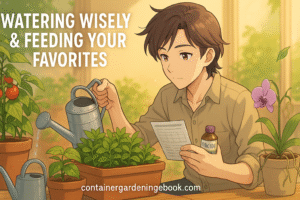
Watering Wisely & Feeding Your Favorites
Alright, you’ve chosen the perfect pot, filled it with gourmet potting mix, and picked out your plant’s future best friends. Now comes the part where you truly embody the role of benevolent plant parent: keeping them hydrated and well-fed. Think of it as managing their personal spa and Michelin-star restaurant, all rolled into one.
Watering Wisely: The Hydration Tango
In the world of container gardening, your plants aren’t just thirsty; they’re living in a fast-paced, high-evaporation environment compared to their in-ground cousins. That perfect, fluffy potting mix? It’s a drainage champion, which means water moves through it quickly. And those sun-drenched balconies? They’re like a plant’s personal sauna. This all translates to one golden rule: container plants need more frequent watering.
But here’s the kicker: it’s not about HOW MUCH water you give them, but WHEN and HOW. Too much love (water) and you’ll drown their little rooty lungs, leading to the dreaded root rot – essentially a slow, slimy demise. Too little, and they’ll stage a dramatic fainting spell, dropping leaves faster than a celebrity’s approval ratings. You’re aiming for the Goldilocks zone: not too wet, not too dry, but JUST RIGHT.
So, how do you know when it’s time for a drink? Forget the calendar, ignore the clock. Your best tool is surprisingly simple: your finger. Stick it about an inch or two deep into the potting mix.
- If it feels dry: Time to water!
- If it feels damp: Hold off. They’re still sipping.
When you do water, water thoroughly until you see it draining out of the bottom holes. This ensures the entire root ball gets a drink, not just the top layer. And speaking of drainage, remember our earlier chat? Those holes are their emergency exits, so make sure they’re never blocked. Early morning is usually the best time to water – it gives the plants a good drink before the midday sun kicks in, and allows any excess moisture on leaves to evaporate, reducing fungal issues.
Feeding Your Favorites: The Nutrient Nosh
Your premium potting mix came packed with nutrients, but think of it like a delicious, but finite, buffet. As your plants grow and you water them, those vital nutrients slowly leach out of the pot. Eventually, your plants will be staring at an empty plate, politely (or not so politely, via yellowing leaves) asking for more. This is where you step in as the gourmet chef.
Unlike in-ground gardens where soil microbes are constantly breaking down organic matter to provide a steady supply of food, your container plants are entirely dependent on YOU for their nutritional needs. Think of plant food as their multivitamin, or maybe a fancy protein shake, tailor-made for their growth spurts.
There are two main ways to feed your hungry container crew:
A crucial word of caution: More isn’t always better! Over-fertilizing can burn your plant’s roots, leading to wilting, browning leaves, and overall unhappiness. Always, always follow the package directions. When in doubt, err on the side of giving a little less than recommended. Your plants would rather be slightly peckish than suffer from a nutrient overdose.
With consistent, mindful watering and a regular feeding schedule, your container garden won’t just survive; it’ll thrive, rewarding you with an abundance of homegrown deliciousness. Now go forth and nurture!
Sunlight Secrets: Positioning Your Plants for Success
Alright, you’ve mastered the art of the perfect pot and the gourmet soil. You’re practically a plant sommelier. But even the finest vintage won’t taste good if it’s served in a closet. Similarly, your meticulously chosen plants won’t produce a single edible leaf if they’re stuck in the dark. Welcome to the world of sunlight secrets, where you become a meteorological detective, mapping the solar patterns of your urban jungle.
Think of sunlight as your plant’s personal energy drink, its fuel, its very raison d’être. Without it, they’re just… sad, green lumps. And unlike us, who can binge-watch Netflix in a dimly lit room, plants are hardcore solar-powered machines. They literally eat sunshine. So, giving them the right amount is less of a suggestion and more of a life-or-death ultimatum.
Now, when a seed packet proudly declares “Full Sun!”, it’s not just bragging about its tan. It means a solid six to eight hours of direct, unfiltered sunlight PER DAY. Not “bright indirect light,” not “a fleeting glimpse of dawn,” but proper, honest-to-goodness sunbeams. If your balcony gets morning sun but is then plunged into the shadow of a neighboring skyscraper by noon, your sun-worshipping tomatoes are going to be less “beefsteak” and more “sad, stringy noodle.”
But here’s where your container gardening superpower kicks in: portability! Remember how we said you’re the master of your soil destiny? Well, you’re also the master of your plant’s sun exposure. Got a spot that only gets glorious afternoon sun? Move your sun-loving peppers there for the latter half of the day. Is your basil looking a bit leggy and pale? It’s probably stretching for light, so give it a prime, sun-drenched spot. Chasing the sun isn’t just a fun daily ritual; it’s practically a sport for the dedicated container gardener.
Becoming a Solar Strategist: Your Daily Sun Census
To truly optimize your plant’s sun intake, you need to become a sun-spotting pro.
- Observe Your Space: Spend a day (or several) charting the sun’s path across your balcony, patio, or windowsill. Where does it hit first? Where does it linger? Are there any sneaky shadows from buildings or trees that creep in at certain times? Grab a pen and paper, or just your phone camera, and document it. You’ll be surprised how much it changes!
- Know Your Plants’ Preferences: Not all plants are sun hogs. While tomatoes and peppers crave the full monty, leafy greens like lettuce and spinach, and many herbs (like mint or parsley), are perfectly happy with partial sun (4-6 hours) or even a bit of afternoon shade to prevent bolting (when they prematurely go to seed). Matching the plant to the light available is key.
- Rotate, Rotate, Rotate: Just like you might rotate your tires (or your laundry, eventually), rotate your pots! This ensures all sides of the plant get their fair share of sunshine, promoting even growth and preventing one-sided, leaning specimens.
- Think Vertically (and Reflectively): If you’re really short on horizontal sun real estate, consider vertical planters. Also, strategically placed light-colored walls or even mirrors (use caution with mirrors to avoid scorching plants) can bounce extra light back onto your plants, giving them a much-appreciated boost.
Ultimately, understanding your microclimate’s sunlight patterns is like having a secret weapon. It allows you to place your plants precisely where they’ll be happiest, ensuring they grow strong, healthy, and produce a bountiful harvest. So, grab your sunglasses and your sun-seeking attitude – your plants are depending on you to deliver that golden goodness!
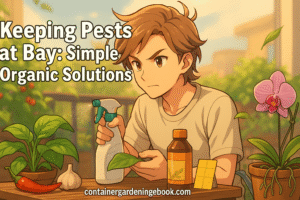
Keeping Pests at Bay: Simple Organic Solutions
So, you’ve got your plants basking in the perfect amount of sun, sipping on their nutrient-rich cocktails, and generally living their best container lives. But just when you think you’ve cracked the code to urban gardening bliss, a tiny, uninvited guest decides your prize basil plant looks like the perfect five-star buffet. Don’t panic! Unlike an in-ground garden where a pest outbreak can feel like a full-scale invasion of Normandy, container gardening offers you a secret weapon: portability and isolation.
Remember how you can just pick up your pot and move it? That same superpower applies to pest control. See a rogue aphid colony setting up shop on your kale? Isolate that pot! Treat it! Your other plants remain blissfully unaware, enjoying their pest-free existence. This isn’t a war; it’s more like targeted diplomacy, preferably with a strong, organic solution.
The key to keeping your container garden pest-free is vigilance and a proactive approach, leaning heavily on natural, organic methods. Forget the harsh chemicals that turn your edible paradise into a no-go zone for anything but hazmat suits. We’re aiming for a harmonious ecosystem, not a chemical wasteland.
Here’s a look at two of your primary organic weapons in the battle against tiny invaders, followed by a friendly showdown:
Let’s dive deeper into these two titans of organic pest control:
Manual Patrol: Your Daily Bug Safari
This is the most direct, and often the most satisfying, method. Imagine yourself as a vigilant plant detective, magnifying glass (or just your keen eyes) in hand, patrolling your green empire daily. The moment you spot a cluster of aphids, a sneaky spider mite web, or a lone caterpillar munching away, it’s go-time.
Your arsenal? Your fingers, a gentle stream of water, and perhaps a cotton swab dipped in rubbing alcohol for stubborn scale insects. Squishing is effective (and surprisingly cathartic), but a strong blast of water from a spray bottle or hose can dislodge many soft-bodied pests like aphids. Check under leaves, in crevices, and along stems – these little villains are masters of hide-and-seek. The humor here comes from the sheer absurdity of it: you, a sophisticated urbanite, meticulously inspecting a basil leaf for microscopic invaders. It’s a humbling, yet empowering, experience. This method is fantastic for early detection and keeping small problems from becoming big ones. Plus, it’s free!
Neem Oil Spray: Your Plant’s Personal Force Field (with a Unique Scent)
If manual patrol is the surgical strike, Neem oil is your broad-spectrum, organic deterrent. Derived from the seeds of the neem tree, this natural oil is a game-changer. It doesn’t instantly kill pests on contact like a harsh chemical. Instead, it works by disrupting their feeding, growth, and reproduction cycles. Pests literally forget how to eat, grow, and make more baby pests. It’s like a slow, organic psychological warfare.
To use it, you typically dilute it with water and a tiny bit of mild soap (as an emulsifier) and spray your plants thoroughly, making sure to coat the tops and, crucially, the undersides of leaves. It’s effective against a wide range of common garden pests, including aphids, spider mites, whiteflies, and even powdery mildew. The catch? It has a distinct, slightly garlicky/nutty smell that some people find… unique. But trust us, it’s a small price to pay for pest-free edibles. Apply it in the early morning or late evening to avoid burning leaves in direct sun and to protect beneficial insects who are less active then. It’s your plants’ gentle, yet firm, bodyguard.
Beyond the Bug Hunt: Other Organic Strategies
- Healthy Plants are Happy Plants: The best defense is a good offense! Well-fed, properly watered, and adequately sunlit plants are more resilient and less attractive to pests. Think of it like a strong immune system.
- Companion Planting: Some plants act like natural bodyguards. Marigolds can deter nematodes, nasturtiums can act as a “trap crop” for aphids (they’ll go for the nasturtiums instead of your veggies), and herbs like mint and basil can confuse pests with their strong aromas.
- Encourage Beneficial Insects: Attract friendly predators like ladybugs, lacewings, and hoverflies by planting flowers that provide nectar and pollen. These tiny assassins will happily munch on your pest problems.
- Good Air Circulation: Crowded plants are a breeding ground for pests and fungal diseases. Give your plants some breathing room!
- Quarantine Newbies: Always inspect new plants thoroughly before introducing them to your established garden. You don’t want to invite trouble to the party.
By combining vigilance, a bit of elbow grease, and the power of nature, you can keep your container garden thriving and your homegrown produce delicious and pest-free. Happy hunting!
Harvesting Your Hard Work: Tips for a Continuous Yield
Congratulations, urban farmer! You’ve nurtured, watered, fed, and serenaded your leafy (and fruiting!) friends, and now comes the moment of truth: the delicious payoff. This isn’t just about snipping a leaf; it’s about claiming your victory, a tangible, edible testament to your green thumb prowess. Think of it as your plants finally paying rent, in the most delicious way possible.
But hold your horses (or your garden shears)! Harvesting isn’t just a free-for-all. There’s an art to it, especially if you want your plants to keep giving back, like a generous (and endlessly productive) relative. The goal is a continuous yield, not a one-and-done raid.
The Great Harvest Heist: When to Pounce
Knowing when to harvest is like knowing when to open that perfectly aged bottle of wine – timing is everything.
- Leafy Greens (Lettuce, Spinach, Arugula): Don’t wait until they look like they’re ready for a botanical retirement home. For “cut-and-come-again” varieties, start harvesting outer leaves when they’re a good size (usually 4-6 inches). This encourages the plant to produce more new leaves from the center. If you let them get too big, they might get bitter or decide to “bolt” (send up a flower stalk and go to seed), effectively ending their leafy production. It’s like they’re saying, “My work here is done, I’m off to reproduce!”
- Herbs (Basil, Mint, Parsley, Thyme): The more you snip, the bushier they get! For most herbs, you want to harvest before they flower, as flowering can diminish flavor. Pinch off sprigs from the top, just above a leaf node (where leaves emerge from the stem). This tells the plant, “Hey, grow two new branches here!” For basil, don’t be shy – regular pinching is key to preventing it from getting leggy and sending up flowers. Think of it as giving your herb a stylish haircut, not a buzzcut.
- Bush Beans: Pick them when the pods are firm, plump, and snapping crisp, but before the beans inside start to bulge significantly. The more you pick, the more flowers the plant will produce, leading to more beans! It’s an edible feedback loop.
- Radishes: These speedy little guys are often ready in just 3-4 weeks. Pull one up when the root is about 1 inch in diameter. If you wait too long, they can get woody, tough, and intensely spicy. Nobody wants a radish that bites back too hard.
- Peppers (Bell & Chili): Harvest sweet peppers when they reach their full size and desired color (green, red, yellow, etc.). Chili peppers can be picked green for a milder flavor or left on the plant to ripen to their mature color for more heat. Use sharp shears to cut the stem, leaving a small piece attached to the pepper. Don’t yank them off, or you might damage the plant.
- Dwarf/Bush Tomatoes: Pick when they’re fully colored and feel slightly soft when gently squeezed. A ripe tomato should easily detach from the vine with a slight twist. If it’s holding on for dear life, it’s not quite ready for its starring role in your salad.
The Tools of the Trade (and How to Use Them)
You don’t need a fancy combine harvester for your container garden. Your trusty kitchen scissors are about to get a promotion!
- Sharp Scissors or Pruning Shears: Essential for clean cuts that promote healing and regrowth. No ripping, tearing, or wrestling with your plants!
- A Basket or Bowl: For collecting your glorious bounty. Because nothing says “I’m a successful urban gardener” like strolling back inside with a bowl full of homegrown goodness.
The Golden Rule of Continuous Yield: Don’t Be a Hoarder!
This is perhaps the most crucial tip: harvest frequently! Your plants are programmed to produce seeds to ensure the next generation. By regularly picking their leaves, fruits, or roots, you’re essentially tricking them into thinking they haven’t achieved their reproductive goal yet. So, they keep producing more and more in a desperate (and delicious) attempt to fulfill their destiny.
If you leave ripe produce on the plant, it signals to the plant that its job is done, and it will slow down or stop producing new flowers and fruits. So, be ruthless (in the kindest, most plant-friendly way possible). The more you pick, the more your container garden will give. It’s like a magical edible ATM, but instead of cash, it dispenses fresh basil.
So go forth, harvest with confidence, and enjoy the unparalleled taste of your very own homegrown deliciousness. Your taste buds (and your ego) will thank you.
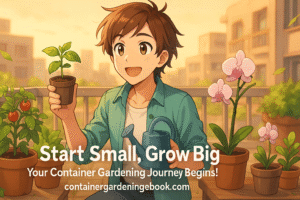
Start Small, Grow Big: Your Container Gardening Journey Begins!
Alright, urban trailblazer, you’ve officially graduated from “staring longingly at garden photos” to “armed with enough knowledge to conquer a rogue tomato plant.” You’ve learned about choosing the perfect plant pad, crafting gourmet soil, mastering the hydration tango, chasing the sun like a dedicated paparazzi, and even engaging in polite (but firm) diplomacy with uninvited bug guests. You’ve practically earned a Ph.D. in Potting!
Now, the moment of truth: it’s time to actually get your hands dirty. We know, we know. The sheer volume of information might feel like trying to drink from a firehose, and your inner perfectionist might be screaming, “But what if I mess it up?!” Take a deep breath. This isn’t brain surgery; it’s just dirt and plants. And the beauty of container gardening? The stakes are hilariously low.
Don’t aspire to be a gardening guru on day one. Forget the dream of transforming your entire fire escape into a cascading jungle of zucchini (unless you really like zucchini, and have very understanding downstairs neighbors). Your mission, should you choose to accept it, is to start small. Seriously. Pick one pot. One herb. Maybe a single, brave lettuce plant. Think of it as a trial run, a low-commitment fling before you settle down with a whole family of edible greenery.
Your first harvest might be a single, perfect basil leaf, or a radish so crisp it practically sings. And let us tell you, that one leaf, that one radish, will taste better than anything you’ve ever bought. Why? Because you grew it. You coaxed it from a tiny seed (or a slightly larger seedling), nurtured it, and protected it from nefarious aphids. That’s not just food; that’s a triumph of will over concrete.
This journey isn’t just about the delicious produce (though that’s a huge bonus). It’s about the quiet satisfaction of nurturing life, the therapeutic rhythm of watering, the pure joy of watching something grow. It’s about transforming a forgotten corner into a vibrant, living space. It’s about proving to yourself (and your skeptical cat) that you do have a green thumb, even if it’s currently covered in a bit of potting mix.
So, ditch the analysis paralysis, grab that first bag of potting mix, and pick a pot. Your urban oasis, however small it begins, is waiting. And your future self, munching on a homegrown tomato, will be sending you silent, delicious thank you notes. Go forth and grow!
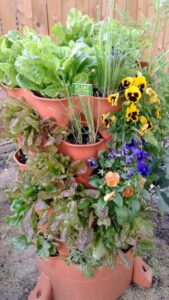
Why the Garden Tower Project Could be the Perfect Option!
Okay, so you’ve embraced the container life, you’re high-fiving your basil plant, and you’re feeling like a bona fide urban farming legend. But what if you could take that tiny urban footprint and make it even tinier, while simultaneously multiplying your yield and solving the eternal “what do I do with my food scraps?” dilemma? Prepare to meet the superhero of vertical gardening, the Garden Tower Project!
Think of it as the ultimate multi-story apartment building for your plants, complete with its own built-in, five-star composting restaurant. If traditional container gardening is like building a cozy bungalow, the Garden Tower is a bustling, self-sufficient skyscraper. It’s designed for those of us who looked at our small space and thought, “There must be a way to grow more than just a single tomato plant without resorting to a complex system of pulleys and ropes.”
Here’s why this ingenious contraption might just be your new best friend (and your plant’s personal paradise):
Vertical Victory: More Plants, Less Footprint!
Remember how we sighed about the lack of dirt? The Garden Tower laughs in the face of horizontal limitations. It’s a vertical marvel, allowing you to grow up to 50 plants in roughly four square feet. That’s right, 50 plants! Imagine the sheer volume of leafy greens, herbs, and compact veggies you can cram into one glorious, space-saving tower. Your neighbors will think you’ve unlocked a secret dimension.
The Worm Composting Wonderland: Your Soil’s Secret Sauce!
This is where the Garden Tower truly earns its “genius” badge. At its core is a perforated compost tube. Instead of painstakingly managing a separate compost bin (or, let’s be honest, just tossing those veggie scraps in the trash), you simply toss your kitchen waste directly into the tower’s central tube. Worms (your new, adorable, subterranean employees) will then do the dirty work, migrating from the compost tube into the surrounding soil pockets. They’ll munch on your scraps, depositing nutrient-rich castings directly into your plant’s root zones. It’s like having an on-demand, all-you-can-eat, organic fertilizer factory running 24/7. Your plants won’t just be fed; they’ll be feasting on gourmet, worm-processed deliciousness, courtesy of your leftover banana peels. Say goodbye to that “takeout container” compost!
Watering Wizardry: The Hydration Cascade!
Forget individually watering 50 different pots. With the Garden Tower, you water from the top, and gravity (the unsung hero of lazy gardeners) does the rest. Water trickles down through the entire system, ensuring even moisture distribution. Plus, because the composting action helps retain moisture, you often end up watering less frequently than with individual pots. It’s the ultimate efficient hydration tango.
Pest Protection (and Portability, Still!):
While no garden is entirely pest-proof, the elevated nature of the Garden Tower can help deter some ground-crawling nuisances. And yes, many models come with wheels, meaning you can still play your favorite game of “Chasing the Sun” or “Rogue Pigeon Evacuation” without breaking a sweat.
The Ultimate Soil Destiny:
Because you’re constantly adding organic matter through the compost tube, the Garden Tower essentially creates its OWN living, breathing, nutrient-rich soil. You’re not just the master of your soil destiny; you’re the benevolent deity overseeing an entire, self-sustaining soil ecosystem. It’s the kind of fluffy, aerated, spa-like living conditions your plant roots could only dream of in a regular pot.
So, when you’re ready to level up your container gardening game, maximize your yield in minimal space, and transform your kitchen scraps into homegrown gold, the Garden Tower Project might just be the vertical, composting, plant-producing powerhouse you’ve been searching for. It’s not just gardening; it’s a small-space revolution!

Leave a Reply